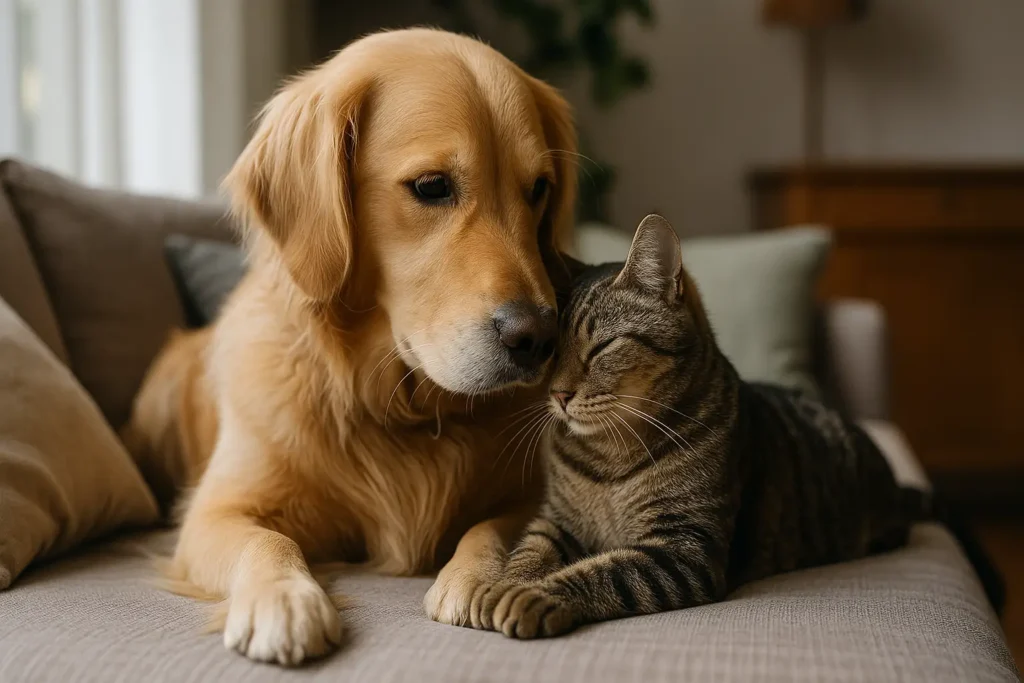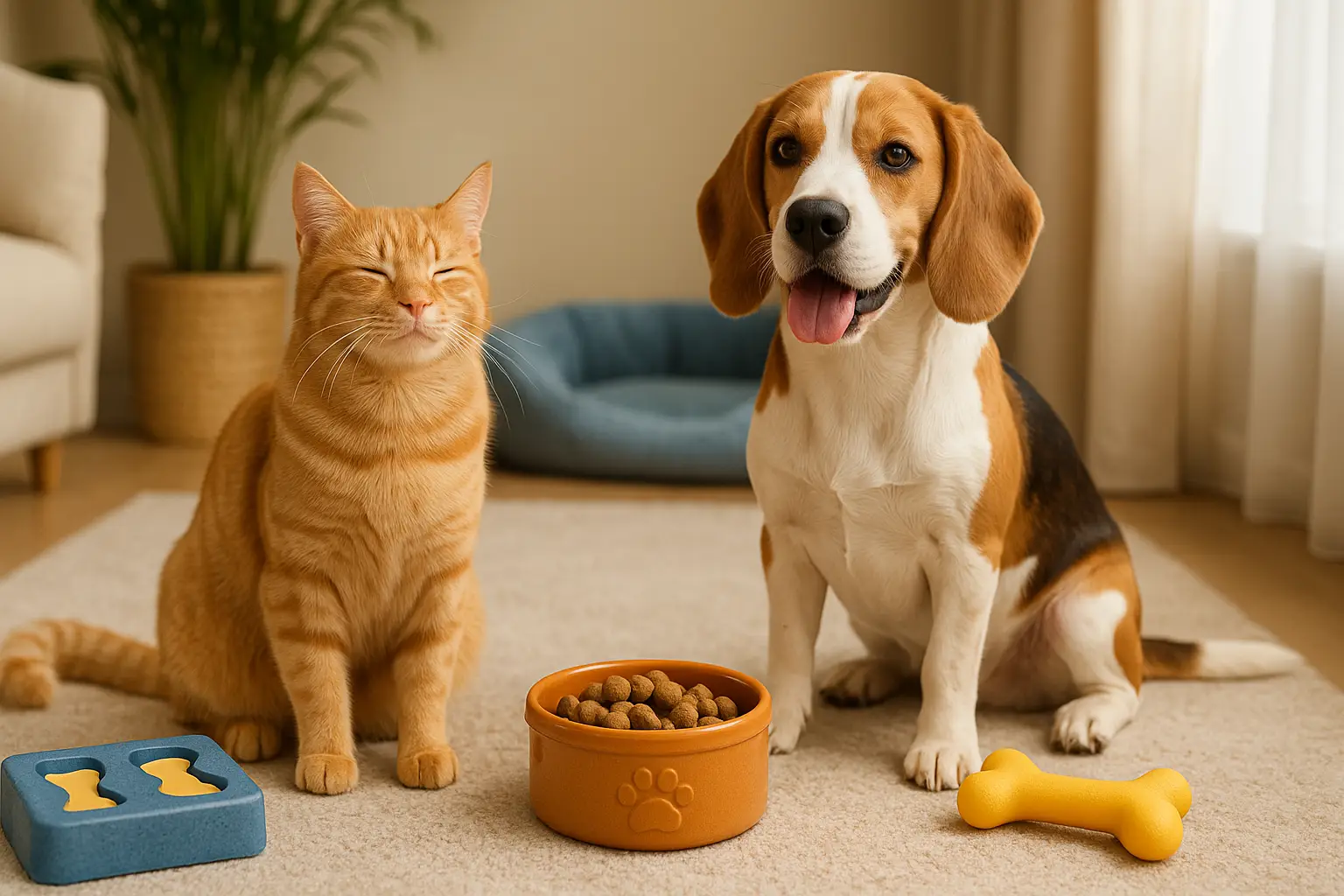How to Support Your Pet’s Mental Health at Home
We often talk about our own mental well-being, but what about our pets? Like humans, animals experience a full spectrum of emotions—joy, anxiety, boredom, fear, excitement, and grief. Supporting your pet’s mental health is just as important as feeding them or taking them for walks. A mentally healthy dog or cat is more resilient, affectionate, and better behaved.
But how do you know if your pet’s mental health needs attention? And what can you do every day to help?
In this comprehensive guide, we’ll explore signs of emotional distress, daily habits to boost emotional wellness, and how to create an environment where your pet feels safe, loved, and mentally fulfilled.

Why Mental Health Matters for Pets
Mental health affects every area of your pet’s life—from how they eat and sleep to how they interact with people and other animals. When mental well-being is neglected, physical health and behavior suffer too.
Effects of Poor Mental Health in Pets:
- Increased anxiety or fear responses
- Destructive behavior (chewing, scratching, digging)
- Loss of appetite or overeating
- Withdrawal or aggression
- Excessive vocalization or clinginess
- Repetitive behaviors (licking, pacing, spinning)
Recognizing these behaviors as signs of emotional struggle—rather than “bad behavior”—is key to healing and support.
Step 1: Recognize the Signs of Mental Distress
Understanding your pet’s baseline behavior is the first step to identifying emotional issues.
Watch for:
- Sudden changes in energy levels
- Loss of interest in play or interaction
- Avoidance or hiding
- Overgrooming or fur pulling (cats)
- Tail tucking, cowering, or flattened ears
- Compulsive behaviors like spinning or licking walls
These signs suggest deeper emotional needs. Don’t ignore them—respond with compassion and structure.
Step 2: Build a Stable Daily Routine
Pets feel safest when life is predictable. Routine provides emotional security, especially for anxious pets.
Establish a Daily Rhythm:
| Time | Activity |
|---|---|
| 7:00 AM | Calm greeting, breakfast, walk/play |
| 12:00 PM | Enrichment toy and quiet time |
| 3:00 PM | Training or cuddling |
| 6:00 PM | Dinner and short walk or play |
| 9:00 PM | Wind-down with soft music or brushing |
Even pets who seem independent benefit from predictable meals, exercise, and companionship.
Step 3: Provide Daily Enrichment
Boredom is a major contributor to anxiety and depression in pets. Enrichment keeps your pet mentally active and emotionally balanced.
Types of Enrichment:
- Food puzzles and slow feeders
- Training sessions (tricks, obedience, scent work)
- Exploratory play (new toys, boxes, hidden treats)
- Interactive games (hide and seek, fetch, wand play)
- Environmental changes (rotated furniture, scents, textures)
Mental stimulation reduces stress and improves confidence—especially for shy or aging pets.
Step 4: Practice Positive Reinforcement
The way we train our pets has a major impact on their mental health. Punishment can create confusion, fear, or withdrawal.
Instead, use positive reinforcement:
- Reward good behavior with praise, treats, or toys
- Ignore or redirect unwanted behaviors
- Use consistent cues and feedback
- Keep sessions short, clear, and encouraging
Training is more than obedience—it’s relationship-building that supports emotional growth.
Step 5: Allow for Social Interaction (With Boundaries)
Pets are social by nature, even if their preferences vary. Isolation and loneliness harm mental well-being.
Social Options:
- Human companionship (sitting nearby, talking softly)
- Playdates with calm, compatible pets
- Walks in dog-friendly areas
- Watching birds or street life through a window (cats)
Balance social time with space. Not all pets want constant interaction—respect their signals.
Step 6: Create a Safe Environment
A peaceful home is essential for emotional wellness. Loud noises, unpredictable routines, and clutter can raise stress levels.
Tips:
- Set up quiet zones or covered beds for downtime
- Keep pet areas clean and organized
- Use soft lighting and calming music
- Avoid shouting or sudden disruptions
- Provide scent items (blankets, your worn shirt)
Safe spaces help pets decompress after stimulation or stress.
Step 7: Incorporate Gentle Physical Contact
Touch is a powerful emotional connector—when done respectfully.
Ways to Offer Comfort Through Touch:
- Light brushing or stroking
- Massage behind ears or along the spine
- Resting your hand nearby, letting them choose closeness
- Holding or cuddling (if welcomed)
Some pets prefer proximity over petting. Let them set the pace.
Step 8: Include Your Pet in Your Life
Many pets feel emotionally disconnected when excluded from daily routines.
Ways to Include Your Pet:
- Talk to them while you work or cook
- Sit together during downtime
- Offer workspace near your desk
- Involve them in chores like laundry or gardening
Being “part of the pack” reduces emotional isolation—even without active play.
Step 9: Play With Purpose
Play is more than physical activity—it’s emotional expression. It builds confidence, strengthens bonds, and relieves stress.
Tips:
- Keep sessions short and frequent (5–15 minutes)
- Use toys that mimic natural instincts
- Celebrate effort, not perfection
- End on a positive note
Play should never feel forced or overwhelming. Watch your pet’s cues.
Step 10: Allow Rest and Recovery
Mental health isn’t just about stimulation—it’s about balance.
Build In:
- Regular nap times
- Quiet zones without interruption
- Space after meals or play
- Limited noise and screen exposure
Respect your pet’s need for calm just as much as their need for fun.
Step 11: Support Emotional Transitions
Major life changes (moves, travel, new pets, or routines) can trigger emotional stress.
Transition Tips:
- Maintain existing routines as much as possible
- Provide comfort items (beds, toys, familiar scents)
- Introduce new environments slowly
- Offer calm praise and reassurance
Give extra attention during transitions—your presence is their stability.
Step 12: Use Tools That Soothe
Some pets benefit from calming aids or sensory supports.
Consider:
- Calming music (YouTube or streaming for pets)
- Thunder shirts or pressure wraps (for anxious dogs)
- Catnip, silvervine, or valerian (for cats)
- Scent diffusers with lavender or pheromones (vet-approved)
Always monitor reactions and avoid overuse.
Step 13: Pay Attention to Nutrition and Hydration
Emotional health is closely tied to physical well-being.
- Feed high-quality food appropriate to age and breed
- Stick to regular mealtimes
- Offer enrichment-based feeding (puzzles, treat balls)
- Keep water fresh and bowls clean
Poor diet or dehydration can amplify anxiety, fatigue, and irritability.
Step 14: Observe and Adapt to Aging or Medical Needs
Senior pets often develop anxiety or confusion due to cognitive decline, pain, or hearing/vision loss.
Supportive Steps:
- Keep furniture and feeding areas in consistent locations
- Offer soft bedding and temperature regulation
- Use more scent and voice cues over visual ones
- Limit loud noises and overstimulation
Routine and gentleness become even more important with age.
Step 15: Trust-Building Rituals
Daily rituals help your pet feel seen and valued.
Examples:
- Good morning greeting and calm breakfast prep
- Post-walk cuddle or brushing
- Saying goodnight with a soft voice
- Using their name with warmth
These small actions build lifelong trust and emotional security.
Final Thoughts: A Mentally Healthy Pet Is a Happy Pet
Supporting your pet’s mental health isn’t a luxury—it’s a responsibility. Emotional care is the foundation of a well-adjusted, happy animal who trusts, loves, and engages with the world.
It doesn’t take hours of training or expensive tools. It takes attention. Patience. Compassion. A willingness to say, “I see you—and I care.”
Because at the heart of every tail wag, every purr, every loving gaze is a soul asking for understanding. And when we listen with our hearts, we give our pets the emotional life they deserve.




Post Comment